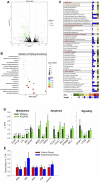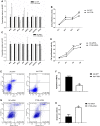Coprophagy Prevention Decreases the Reproductive Performance and Granulosa Cell Apoptosis via Regulation of CTSB Gene in Rabbits
- PMID: 35923240
- PMCID: PMC9341522
- DOI: 10.3389/fphys.2022.926795
Coprophagy Prevention Decreases the Reproductive Performance and Granulosa Cell Apoptosis via Regulation of CTSB Gene in Rabbits
Abstract
Coprophagy is an instinctive behavior in rabbit with important effects on growth and reproductive performance. The underlying mechanism of this effect in rabbit is unknown. Here, we used Elizabeth circle as a coprophagy preventing model in female rabbits and assess feed intake, growth, and reproductive performance. We found that preventing coprophagy did not affect feed intake but decreased body weight and weight of several organs and tissues and resulted in complete reproductive failure during the late pregnancy period, accompanied by reduced levels of plasma progesterone. RNA-seq analysis of rabbit ovarian tissues revealed that preventing coprophagy affected significantly 241 genes (DEGs), with the large majority being downregulated. Bioinformatic analyses revealed that those DEGs are mostly involved in apoptosis, immune response, and metabolic pathways. Among DEGs, the lysosomal cysteine protease cathepsin B (CTSB) was significantly downregulated in the coprophagy prevention group. Further studies using siRNA and adenovirus overexpression systems revealed that CTSB promotes the proliferation of rabbit granulosa cells (GCS) and prevents apoptosis. Measurement of transcripts coding for proteins related to apoptosis revealed a minor transcriptomic effect of CTSB, indicating that its effect is likely post-transcriptional. Overexpression of CTSB increased secretion of progesterone and estradiol, partly via upregulation of CYP19A1 while inhibition of CTSB decreased progesterone secretion partly via downregulation of the StAR gene. In conclusion, our study demonstrated the detrimental effect on reproduction by preventing coprophagy with a main role for this response played by CTSB on the granulosa cells of the ovary.
Keywords: CTSB; coprophagy; granulosa cells; rabbits; reproductive performance.
Copyright © 2022 Song, Wang, Wang, Jiang, Sun, Cai, Sun, Li, Bionaz and Xu.
Conflict of interest statement
The authors declare that the research was conducted in the absence of any commercial or financial relationships that could be construed as a potential conflict of interest.
Figures








Similar articles
-
Coprophagy Prevention Affects the Reproductive Performance in New Zealand White Rabbits Is Mediated through Nox4-ROS-NFκB Pathway.Oxid Med Cell Longev. 2022 Dec 21;2022:8999899. doi: 10.1155/2022/8999899. eCollection 2022. Oxid Med Cell Longev. 2022. PMID: 39282150 Free PMC article.
-
Impact of coprophagy prevention on the growth performance, serum biochemistry, and intestinal microbiome of rabbits.BMC Microbiol. 2023 May 10;23(1):125. doi: 10.1186/s12866-023-02869-y. BMC Microbiol. 2023. PMID: 37165350 Free PMC article.
-
Modulation of Cathepsin S (CTSS) Regulates the Secretion of Progesterone and Estradiol, Proliferation, and Apoptosis of Ovarian Granulosa Cells in Rabbits.Animals (Basel). 2021 Jun 13;11(6):1770. doi: 10.3390/ani11061770. Animals (Basel). 2021. PMID: 34199180 Free PMC article.
-
Cathepsin B Regulates Mice Granulosa Cells' Apoptosis and Proliferation In Vitro.Int J Mol Sci. 2021 Oct 31;22(21):11827. doi: 10.3390/ijms222111827. Int J Mol Sci. 2021. PMID: 34769258 Free PMC article.
-
Effects of miR-101-3p on goat granulosa cells in vitro and ovarian development in vivo via STC1.J Anim Sci Biotechnol. 2020 Oct 14;11:102. doi: 10.1186/s40104-020-00506-6. eCollection 2020. J Anim Sci Biotechnol. 2020. PMID: 33072314 Free PMC article. Review.
Cited by
-
Progestin and adipoQ receptor 7 (PAQR7) mediate the anti-apoptotic effect of P4 on human granulosa cells and its deficiency reduces ovarian function in female mice.J Ovarian Res. 2024 Feb 6;17(1):35. doi: 10.1186/s13048-024-01348-w. J Ovarian Res. 2024. PMID: 38317224 Free PMC article.
-
Coprophagy Prevention Affects the Reproductive Performance in New Zealand White Rabbits Is Mediated through Nox4-ROS-NFκB Pathway.Oxid Med Cell Longev. 2022 Dec 21;2022:8999899. doi: 10.1155/2022/8999899. eCollection 2022. Oxid Med Cell Longev. 2022. PMID: 39282150 Free PMC article.
-
Impact of coprophagy prevention on the growth performance, serum biochemistry, and intestinal microbiome of rabbits.BMC Microbiol. 2023 May 10;23(1):125. doi: 10.1186/s12866-023-02869-y. BMC Microbiol. 2023. PMID: 37165350 Free PMC article.
References
LinkOut - more resources
Full Text Sources
Miscellaneous

